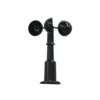YOUNG Wind Sentry Anemometer & Vane
Features
- Anemometer uses three lightweight hemispherical cups to measure wind speed
- Vane employs a balanced assembly with position sensed by a long-life potentiometer
- Precision stainless steel ball bearings are used throughout
- Free ground shipping
- Expedited repair and warranty service
- Lifetime technical support
- More
The YOUNG Wind Sentry Anemometer and Vane are professional quality sensors suitable for a wide range of wind measurement applications. These economically priced sensors provide excellent sensitivity, corrosion resistance, and minimal parts count for easy maintenance.
The anemometer uses three lightweight hemispherical cups to measure wind speed. Cup wheel rotation produces an AC frequency that is linearly proportional to wind speed. The vane employs a balanced vane assembly with vane position sensed by a long life precision potentiometer. Precision stainless steel ball bearings are used throughout.
Range:
Wind Speed: 0-50 m/s (112 mph)
Azimuth: 360° mech.,352° electrical (8° open)
Accuracy:
Wind Speed: ±0.5 m/s (1.1 mph)
Wind Direction: ±5°
Threshold*:
Anemometer: 1.1 m/s (2.5 mph)
Vane: 1.3 m/s (2.9 mph) at 10°
Signal Output:
Wind Speed Signal: AC sine wave, 1 pulse per rev.
Wind Direction Signal: DC voltage from 10Kohm conductive plastic potentiometer, 1% linearity, life expectancy: 50 million revolutions.
Power Requirement: Potentiometer excitation 15 VDC max
Dimensions:
Overall height: 32 cm (12.6 in)
Crossarm Length: 28cm (11.0 in) between instrument centers
Vane length: 22 cm (8.7 in)
Cup wheel diameter: 12 cm (4.7 in)
Crossarm mounting: 34 mm (1.34 in) diameter (standard 1 inch pipe)
Shipping Weight: (03002) 1.3 kg (3 lb)
In The News
Monitoring Mariculture in the Gulf of Alaska
The mariculture industry in the Gulf of Alaska has been steadily growing in recent years, guided by ongoing research to help refine farm location and cultivation practices. A subset of aquaculture, mariculture focuses on rearing organisms in the open ocean. In Alaska, finfish farming is illegal, so most farms cultivate kelp, oysters, or a combination of the two. These small, locally operated farms started popping up in the Gulf of Alaska in the early 1990s, when shellfish farming first became legal. Kelp farming did not begin to catch on in the state until 2016. Many of the coastal areas that have grown interested in mariculture are historically commercial fishing communities.
Read MoreSupplying Seattle’s Drinking Water: Using Data Buoys to Monitor the Cedar River Municipal Watershed
Providing clean, safe, and reliable drinking water for the 1.6 million people in the greater Seattle area is a top priority for Seattle Public Utilities (SPU). With limited water supplies, SPU dedicates considerable resources to maintain its watersheds and mountain reservoirs. About 70 percent of Seattle Water comes from the Cedar River Municipal Watershed , and the other 30 percent comes from the South Fork Tolt River Watershed . [caption id="attachment_39574" align="alignnone" width="940"] Data buoy in Chester Morse Lake . (Credit: Kevin Johnson / Seattle Public Utilities) [/caption] Jamie Thompson, a fisheries biologist at SPU, monitors aquatic ecosystems centered on fish listed under the U.S. Endangered Species Act (ESA).
Read MoreData-Driven Advocacy on the Lower Deschutes River
Like many freshwater environments, the Deschutes River in Oregon is under pressure from development, pollution, and climate change. Many rivers, streams and lakes in the Deschutes Basin do not meet Oregon water quality standards –where state water quality monitoring assesses levels of bacteria, pH, dissolved oxygen, temperature, and fine sediment. Hannah Camel is the Water Quality Coordinator for the Deschutes River Alliance (DRA), a non-profit organization that focuses on the health of the lower 100 miles of the Deschutes River–the area most affected by human intervention. As a data-driven organization, the DRA has benefited from the installation of two NexSens X2 data loggers.
Read More












